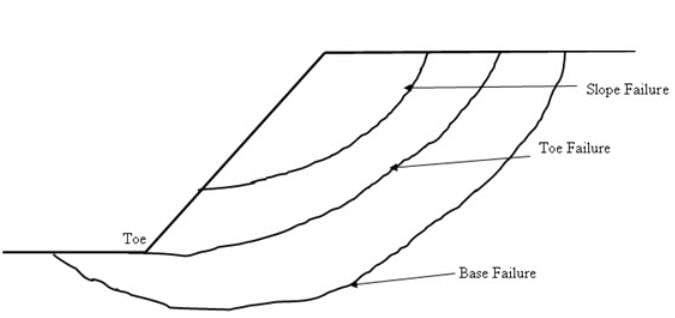Agricultural Engineering Exam > Agricultural Engineering Notes > Soil Mechanics Notes- Agricultural Engineering > Finite Slope - Slope Stability, Soil Mechanics
Finite Slope - Slope Stability, Soil Mechanics | Soil Mechanics Notes- Agricultural Engineering PDF Download
Finite Slope
There are three types of slope failure such as (as shown in Figure 29.1):
Slope Failure: In this type of failure, failure surface intersects the slope above the toe. It occurs when slope angle is high and soil close to toe is strong and soil in the upper part of the slope is strong.
Toe Failure: Most common type of failure. In this type of failure, failure surface passes trough the toe. It occurs for steep slopes and when soil above and below the base is homogeneous.
Base failure: In this type of failure, failure surface passes below the toe. It occurs for flat slopes and when soil below the base is relatively week.
Fig. 29.1. Various failure surfaces.
The document Finite Slope - Slope Stability, Soil Mechanics | Soil Mechanics Notes- Agricultural Engineering is a part of the Agricultural Engineering Course Soil Mechanics Notes- Agricultural Engineering.
All you need of Agricultural Engineering at this link: Agricultural Engineering
FAQs on Finite Slope - Slope Stability, Soil Mechanics - Soil Mechanics Notes- Agricultural Engineering
| 1. What is slope stability in soil mechanics? |  |
Slope stability in soil mechanics refers to the ability of a slope or embankment to resist failure or collapse. It is a critical factor in determining the safety of structures built on or near slopes, such as roads, buildings, and retaining walls. Slope stability analysis involves evaluating the forces acting on the slope and assessing the shear strength of the soil to determine the likelihood of slope failure.
| 2. How is slope stability assessed in agricultural engineering? |  |
In agricultural engineering, slope stability is assessed by conducting geotechnical investigations and slope stability analysis. Geotechnical investigations involve collecting soil samples, conducting laboratory tests, and assessing the physical and mechanical properties of the soil. Slope stability analysis methods, such as the limit equilibrium method or numerical modeling, are then used to determine the factors of safety and predict the stability of the slope under various loading and environmental conditions.
| 3. What factors affect slope stability in soil mechanics? |  |
Several factors can affect slope stability in soil mechanics. The key factors include the angle of the slope, the type and characteristics of the soil, the presence of water, the vegetation cover, and external loads on the slope. Steeper slopes, weak or loose soils, high water content, lack of vegetation cover, and excessive external loads can all contribute to reduced slope stability and an increased risk of slope failure.
| 4. What are the consequences of slope failure in agricultural engineering? |  |
Slope failure in agricultural engineering can have severe consequences. It can lead to the collapse of embankments, roads, or structures, posing a threat to human life, livestock, and agricultural activities. Slope failure can also result in soil erosion, loss of fertile topsoil, contamination of water bodies, and disruption of irrigation systems. These consequences can significantly impact agricultural productivity, sustainability, and the overall economy of an area.
| 5. How can slope stability be improved in agricultural engineering? |  |
There are several methods to improve slope stability in agricultural engineering. These include implementing proper drainage systems to control water content, constructing retaining walls or slope stabilization structures, terracing the slope to reduce its inclination, and establishing vegetation cover to provide root reinforcement and improve soil cohesion. Additionally, appropriate land management practices, such as contour plowing and erosion control measures, can also help maintain slope stability and minimize the risk of slope failure in agricultural areas.
Related Searches















